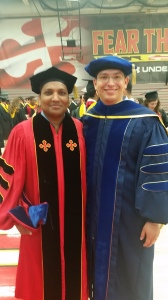Date: July 20, 2015
Time: 2:00 pm
Location : J.M. Patterson Building 3rd floor Fire Protection Engineering Conference Room
Advisory Committee:
Assistant Professor Michael Gollner, Chair
Associate Professor Christopher Cadou, Dean’s Representative
Associate Professor Peter Sunderland
Associate Professor Andre Marshall
Associate Professor Stanislav Stoliarov
Abstract:
Modeling the realistic burning behavior of condensed-phase fuels has remained out of reach, in part because of an inability to resolve complex interactions at the interface between gas-phase flames and condensed-phase fuels. This interaction is even more complex as scales increase, because realistic fires occur under fully turbulent conditions which have yet to be fully replicated or understood at the bench scale, where detailed measurements can be conducted. The current research explores the dynamic relationship between combustible condensed fuel surface and gas-phase flames in both laminar and turbulent boundary layers, representing the small scales in which materials are tested (where much of today’s theoretical knowledge is also isolated) to realistic large-scale turbulent flames present in almost all unwanted fires, hybrid rocket motors and other similar combustion phenomena.
A thorough numerical and experimental investigation of laminar boundary-layer diffusion flames established over the surface of a condensed fuel is presented. By extension of the Reynold’s Analogy, it is hypothesized that the non-dimensional temperature gradient at the surface of a condensed fuel is related to the local mass-burning rate through some constant of proportionality. First, this proportionality is tested by using a validated numerical model for a steady flame established over a condensed fuel surface, under free and forced convective conditions. Second, the relationship is tested by conducting experiments in a free and forced convective environment using methanol and ethanol as liquid fuels and PMMA as a solid fuel, where a detailed temperature profile is mapped during steady burning using fine-wire thermocouples mounted to a precision two-axis traverse mechanism. The results from the present study suggests that there is indeed a unique correlation between the mass burning rates of liquid/solid fuels and the temperature gradients at the fuel surface. The correlating factor depends upon the Spalding mass transfer number and gas-phase thermo-physical properties and works in the prediction of both integrated as well as local variations of the mass burning rate as a function of non-dimensional temperature gradient. Convective and radiative heat feedback from the flames were also measured both in the pyrolysis and plume regions by using temperature gradients near the wall. Additional results from precise measurements of the thermal field are also presented.

